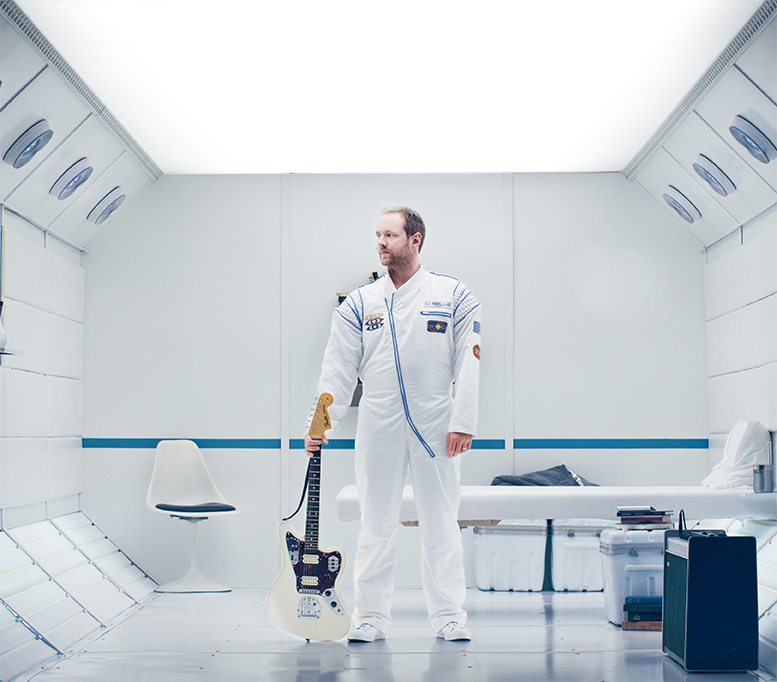Imagine floating around cramped quarters surrounded by wires and whirring machinery for months, with companions you cannot walk out on over disagreements, constantly breathing recycled air, eating packaged food, exercising hours daily to prevent muscle atrophy and drinking water recycled from your urine. Imagine using foot loops and thigh restraints at the loo so as not to float away during the act. Imagine taking a shower inside a cylinder where water droplets and soap bubbles don’t go down a drain but wobble about and you must vacuum every drop from the air, body and shower edge. Imagine space walks, aka repair missions for up to seven hours in a suit costing millions of dollars, where hunger must be satiated with an emergency fruit-cereal bar inside the suit, which must be gobbled in one go to prevent rogue particles from causing complications. Imagine wearing adult diapers all the while, which must be disposed of after re-entry.
One needs Jedi persistence.
Today ‘Space Madness’ sounds comic but in the fifties, it was a tangible fear. Psychiatrists screened prospective astronauts expecting “suicidal deviants”, reports Endeavor. No doubt they drew hypotheses from extensive exposure to madness, and crude sci-fi of the time where criminals of spacefaring civilizations were sent to hostile planets to test habitability.
What they found, to their surprise and disappointment, was not “sexually aberrant thrill seekers” but level-headed professionals “able to absorb extraordinary stresses”.
Yet within decades, unhinged astronauts were common in popular culture, even as real astronauts “demonstrated a remarkable ability to absorb the stresses of long-duration spaceflight.”
To earthlings then, mental anomalies developing from prolonged habitation in an extreme environment seemed quite palatable. And while today’s civilians can realistically speculate playing zero-g soccer and honeymoons to Mars, long duration spaceflight is still unchartered psychological waters.
It’s not all about your red blood cells changing shape or your vertebrae distending. Conditions remain extreme in spite of technical advances and the earth’s visual presence is also a factor.
Michael Collins, the third, largely forgotten crew member of Apollo 11, recounts orbiting the moon while Armstrong and Aldrin waited on the surface. Upon reaching the dark side, Earth disappeared from view and all telecommunications cut off.
“I am alone now, truly alone, and absolutely isolated from any known life. I am it. If a count were taken, the score would be three billion plus two over on the other side of the moon, and one plus God knows what on this side.” (NASA website)
Today’s astronauts are less isolated. Better telecom allows weekly family reunions (time lag varies with distance). A special website lets them access news, reply to posts from family and friends. They watch DVDs, stargaze using telescopes. Canadian astronaut Chris Hatfield recently achieved internet fame for playing David Bowie’s Space Oddity aboard the ISS.
Astronauts often have trouble readjusting upon return. Armstrong and Collins for example, unlike Aldrin, did not take to celebrity and turned reclusive.
“Astronauts also frequently experience unexplained light flashes, sometimes seeing stars even with eyes shut. Traditionally, these are attributed to cosmic ray bombardment and ‘phosphene’ effects.”
The hurdle in diagnosing mental anomalies is an exasperating lack of data. “Astronauts are usually tight-lipped about any mental health problems they’ve encountered for fear of jeopardising their selection for future missions.” Writes psychologist-turned-writer Chris Jarret,who further alleges space agencies are “euphemistic” in owning up to “the role psychological issues have played in mission terminations.”
He cites the 1985 Soviet Salyut 7 mission, where official reports claimed appendicitis or prostatitis as the cause. “Yet subsequent comments from the astronauts… led many to conclude that the crew came home early because one member was depressed.”
But these may be the exception rather than rule.
“In the centre of every big city… surrounded by noise and teeming millions of people, are lonely people. Loneliness is not so much where you are, but instead is your state of mind.” Chris Hadfield philosophized over a recent reddit live-chat from orbit. “On Station with the world in our window, people on the radio, family just a phone call away, and other crew members to chat with, plus a full plate of experiments to do, loneliness is no more of a problem than it is everywhere else.”
The earth’s beauty also, is never tiring.
“I really believe that if the political leaders of the world could see their planet from a distance of 100,000 miles their outlook could be fundamentally changed.” Collins remarked on Apollo 11’s 40th anniversary. “That all-important border would be invisible, that noisy argument silenced. The tiny globe would continue to turn, serenely ignoring its subdivisions, presenting a unified facade that would cry out for unified understanding, for homogeneous treatment. The earth must become as it appears: blue and white, not capitalist or Communist; blue and white, not rich or poor; blue and white…”
In an interview with Ascent magazine, Edgar Mitchell, the sixth man to moonwalk recounts a transcendental experience: “I realized that the molecules of my body and the molecules of the spacecraft had been manufactured in an ancient generation of stars. It wasn’t just intellectual knowledge – it was a subjective visceral experience accompanied by ecstasy.” Within two years after return, Mitchell founded the Institute of Noetic Sciences to “look at spiritual or religious experiences from the point of view of quantum science.”
“Virtually all of the people who went… and especially the farther out that they went, all of them had powerful, powerful experiences.” Mitchell once said to Alternate Perceptions.
Astronauts also frequently experience unexplained light flashes, sometimes seeing stars even with eyes shut. Traditionally, these are attributed to cosmic ray bombardment (craft’s radiation shielding notwithstanding) and ‘phosphene’ effects. The latter is like ‘prisoner’s cinema’, where prolonged exposure to darkness creates a ‘light show’.
These things occur on earth as well, usually reported by meditators, though less frequently. For some reason leaving the earth facilitates them.
Interestingly, Patanjali, the compiler of our yoga-sutras attributed similar experiences to initial efforts directed at opening the third eye…
Last but hardly the least, the most crucial issue regarding space travel, presented as a multiple choice question. Prospective space tourists please take your pick:
a) What else is out there b) Sex in space
I’ll pick atypically subjected to simpering laughter and ridicule. While it is easy to debunk a lot of claims as that of crazies, it is less so when that person is Edgar Mitchell.
While not admitting to first-hand knowledge, the Dailymail has him publicly claiming to “have been privileged enough to be in on the fact that we’ve been visited on this planet and the UFO phenomenon is real.”
According to Wikipedia Mitchell asserts the reality of Roswell and in 2004, “told the St. Petersburg Times that a “cabal of insiders “ in the US government were studying recovered alien bodies, and that this group has stopped briefing US Presidents after JFK.
According to the Dailymail article, Mitchell asserts that our technology is “not nearly as sophisticated” and “had they been hostile” “we would have been gone by now.
More from the same article:
“This is really starting to open up. I think we’re headed for real disclosure and some serious organizations are moving in that direction.” That was in 2008.
NASA’s response: “Dr Mitchell is a great American, but we do not share his opinions on this issue.”
So while scientists offer the usual cautious skepticism regarding conceiving outside the earth’s gravitational field and retired pornstar Coco Brown prepares to be the first to perform in space, fasten your seat belts. Whichever option you picked, the ride could soon get interesting.














